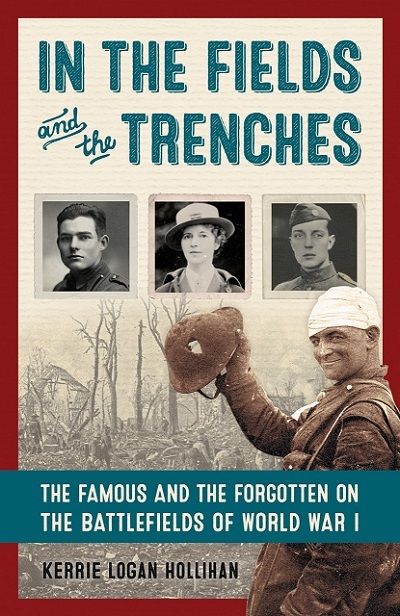After almost three years of bloody fighting by our European allies, Russia, the United Kingdom, and France against the Central Powers of Germany and Austria-Hungary, the United States voted to join forces to help end “the Great War,” the bloodiest war ever known. On April 6, 1917, the U.S. Congress voted its approval, which means that the Centennial is coming up in a few weeks. This seemed to be an apt time to ask my historian colleague, Cheryl Harness to review Kerrie Hollihan’s book In the Fields and the Trenches: The Famous and the Forgotten on the Battlefields of World War I. Sometimes called “the forgotten war” it was known also at the time as the War to End All Wars. Unfortunately, it didn’t.

A century ago, when the United States entered the First World War, in the spring of 1917, no one knew there’d ever be a second. It was “the Great War” then, that boggled people’s minds. The fact that the fighting in Europe and beyond had ground on since the summer of 1914, killing and wounding soldiers and civilians by the millions, seemed impossible enough, let alone another bloodbath even worse a couple of decades later. Indeed, the effects of World War I would ripple on through the 20th century to our present day.
As they meet some of the remarkable individuals who took part in the war, readers young and old will find a lucid explanation of the conflict in Kerrie Logan Hollihan’s IN the FIELDS and the TRENCHES: The Famous and the Forgotten on the Battlefields of World War I (2016). Like her earlier works of fine, well researched nonfiction, such as Elizabeth I, The People’s Queen: Her Life and Times (2011) and Rightfully Ours: How Women Won the Vote (2012), Ms. Hollihan’s book on WWI was published by Chicago Review Press.
In the twelve chapters between the book’s preface and touching epilogue, the author presents her captivating cast of characters, including their own vivid words, a WWI time line, map, and a wealth of archival photographs.
There’s Irene Curie (daughter of Marie, the world-famous physicist) rumbling around battlefields in her mobile X-ray unit, and aviator, Quentin Roosevelt, whose battle death breaks the heart of his father, Theodore, the 25th US president. Another daring “flyboy” (in Britain’s Royal Flying Corps) was Fred Libby, former Nebraska cowboy. There’s Elsie Janis, who left the bright lights of Broadway to entertain the troops overseas. One of them might have been young Buster Keaton, a budding silent movie star before he got drafted. For his part, Christy Mathewson voluntarily traded his major league baseball uniform for that of a soldier.
Because Walter Koessler of Germany brought his camera with him on his way to war, we have a clear idea of what his fellow soldiers, their weapons, and battered surroundings looked like. However quaint these century-old black and white images may appear to us, Ms. Hollihan hammers home the point that the people pictured were as vital and alive as we are now. They missed their distant dear ones, as artillery captain, future president Harry S. Truman made clear in letters to his sweetheart. And they faced injustices, such as the relentless racism that confronted Henry Lincoln Johnson due to the color of his skin. Because of her gender, pioneer aviator Katherine Stinson could train pilots, but fly alongside them? No.
The harrowing experiences of young J.R.R. Tolkien and Ernest Hemingway served as inspiration for masterpieces yet to be written. Still, many who survived the war’s terrors were left so shaken that postwar life proved difficult, so many that one of Hemingway’s friends termed the survivors “the lost generation.” Find them and their comrades here. You’ll be richer for knowing them, even their great and terrible war.
